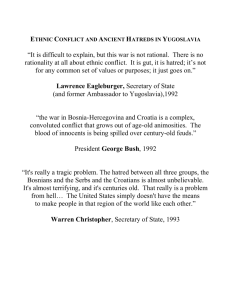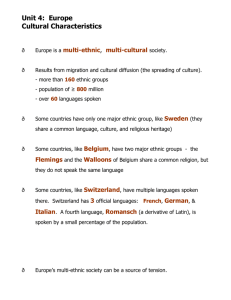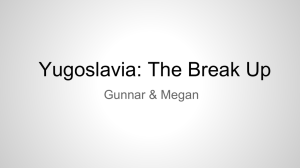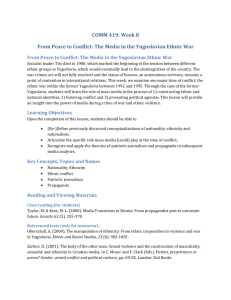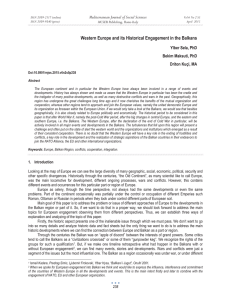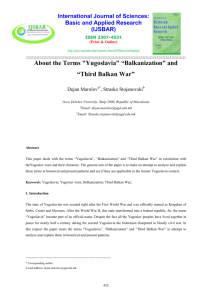the multi-ethnic state and ethnic homogeneity - an
advertisement
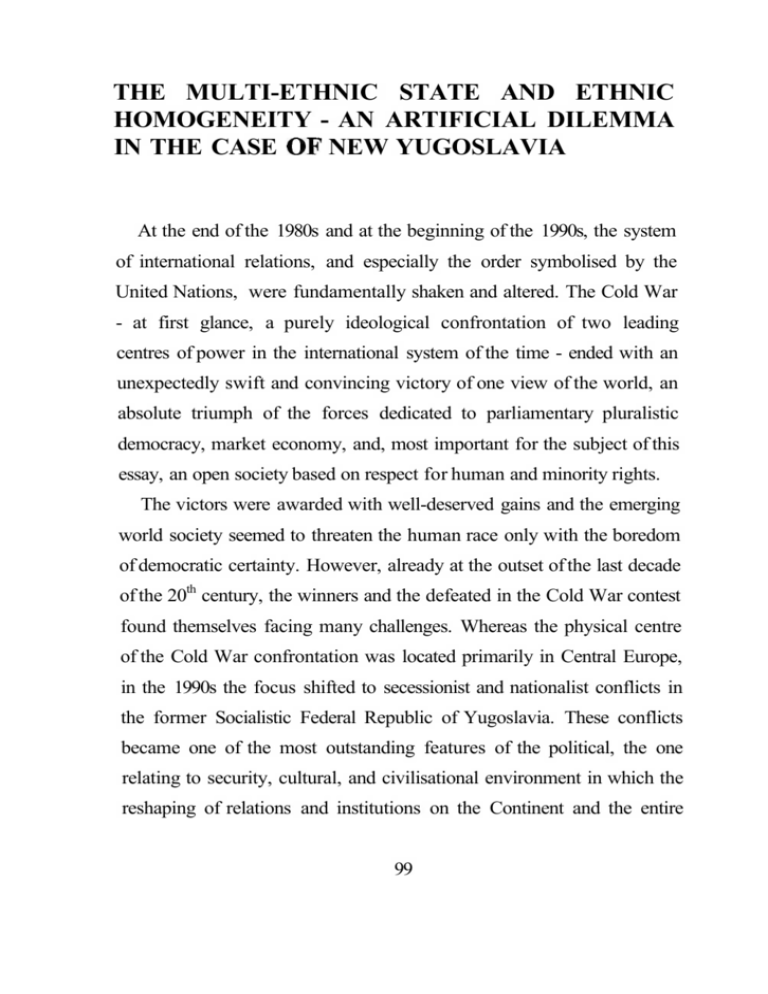
THE MULTI-ETHNIC STATE AND ETHNIC HOMOGENEITY - AN ARTIFICIAL DILEMMA IN THE CASE OF NEW YUGOSLAVIA At the end of the 1980s and at the beginning of the 1990s, the system of international relations, and especially the order symbolised by the United Nations, were fundamentally shaken and altered. The Cold War - at first glance, a purely ideological confrontation of two leading centres of power in the international system of the time - ended with an unexpectedly swift and convincing victory of one view of the world, an absolute triumph of the forces dedicated to parliamentary pluralistic democracy, market economy, and, most important for the subject of this essay, an open society based on respect for human and minority rights. The victors were awarded with well-deserved gains and the emerging world society seemed to threaten the human race only with the boredom of democratic certainty. However, already at the outset of the last decade of the 20th century, the winners and the defeated in the Cold War contest found themselves facing many challenges. Whereas the physical centre of the Cold War confrontation was located primarily in Central Europe, in the 1990s the focus shifted to secessionist and nationalist conflicts in the former Socialistic Federal Republic of Yugoslavia. These conflicts became one of the most outstanding features of the political, the one relating to security, cultural, and civilisational environment in which the reshaping of relations and institutions on the Continent and the entire 99 Euro-Atlantic region was being carried out. Unprepared to deal with the challenges presented by the Yugoslav civil war, which in the demands of the opposing sides confronted the two basic principles of the then political and security order represented by the OSCE - the principle of the inviolability of borders versus the right of self-determination Europe was facing with the most serious crisis on its soil after the Second World War. The question of the position and rights of different minorities (ethnic, religious, lingual, and other) in the Balkans arose at the beginning of the 19th century with the process of the creation of independent national states in the Balkans. Ever since that time it has been continually active, undermining the stability of the region like an underground torrent. The minority problem first appeared as a problem of the position of religious minorities in some Balkans countries. Over time it "survived" alongside the tremendous changes of the social environment as the peoples of this part of Europe belatedly formed their states and gained international recognition. The "malign nationalisms", re-nationalisation and balkanisation, consciously suppressed during the Cold War, appeared on the historical stage in their full destructive force, advertising themselves as the way to the solution of the national issues of Croats, Serbs, Albanians... In the last decade the peoples of the Balkans and Southeastern Europe have been the witnesses and immediate participants of a new outburst of ethnic and religious conflicts, whose atavistic ferocity has dispersed many illusions regarding human nature and human communities 100 expressed, for example, in Hegel's famous vision of the "final rational form of society". That is why we from this part of Europe have a greater responsibility than others to study the roots, essence, and expressions of nationalism and, more importantly, the ways to overcome it in the changed conditions of today. Unfortunately, the gloomy prediction of Michael Clark that "the principle of self-determination which has marked the 20th century will become the curse of the 21st century"1 came true too soon. The epidemic of madness or "ultra-nationalist insanity"2 in the shape of secessionist nationalism in the period of greatly increased institutional velocity of "thick globalism" (Keohame and Nyu Jr.) potentially threatens the whole world in which, according to data from the mid-1990s, there are more than 3600 ethnic groups, but only some 180 internationally recognized countries. On the other hand, as far as the Balkans are concerned it should be said that, in addition to secessionist nationalism, an equally important feature of the inter-ethnic and inter-religious relations on this ethnoreligious "leopard skin" is the fact that minorities, with some honourable exceptions, have never been recognized nor truly respected by the majorities and their national governments. Most Balkan countries conducted a policy of voluntary or forced integration of ethnic and religious groups into the majority group of every individual country. As Prof. Helmut Rititig rightfully noticed, the ethnic national state which 1 Langley, Winston E., Liberation Theology and the Politics of transformation: A Review Essay, transnational Perspectives, Volume 15,1. 1989, p. 23. 2 Kogelfranz, Siegfried, Epidemija ludila, Tanjug pres, Beograd, 3.111993, p. 21 101 was the leading political idea in the 19th century and which "almost destroyed Europe in the 20th", did in some cases tolerate ethnic minorities, but its policy was mainly that of forced assimilation or later expulsion".3 The state of inter-ethnic relations in the Balkans is complicated by the existence of several cultural regions and civilisational types: ByzantineOrthodox in the East, Latin-Catholic in the West and Asiatic-Islamic in the central and southern areas.4 Thus, it happened that the Balkans, at the same time a coherent geographical area and a zone of contact between three world-important religions with complex mutual relations which often led to migrations of members of individual religions and the shaping of ethnical self-consciousness, became and remained a lasting source of confrontation and tensions. However, the ascent of nationalism after the Cold War also had many other causes of various origin: historical, psychological, economic, geopolitical, geoeconomic, military strategic... The international response to these confrontations has varied during the last decade, ranging, as Prof. Oschlies noticed, from unwilling mediation to large-scale military intervention, and in most cases the results were limited to the freezing of the most pronounced enmities and the satisfaction of the most urgent humanitarian needs. The geopolitical re-designing of the Balkans, which came as a result of the 1989 changes, the break-up of Socialist Yugoslavia, a strategic 3 Helmut Rititig, Prava manjina Hi ljudska prava, "Medjunarodna politika", Beograd, 1997, p. 335 102 and ideological buffer of the Cold War period, and the series of secessionist wars, has thoroughly altered the geopolitical appearance of this part of Europe. First, instead of the earlier six, there are now ten states in this region (Albania, Bosnia-Herzegovina, Bulgaria, Croatia, Greece, Macedonia, Romania, Slovenia, Turkey, and Yugoslavia). Second, the earlier regional balance between members of NATO, members of the Warsaw Pact, and non-aligned states has been replaced by a situation in which eight Balkan states are members of NATO or its Partnership for Peace programme, Bosnia-Herzegovina and Yugoslavia being, unfortunately, the only two still remaining outside this system of collective security. According to available data, at the beginning of the 1990s, the ten countries mentioned above had a total population of 126,4 million people - 23,3 million or 18,6 percent of that number were members of minorities, expressing their self-consciousness through 88 various ethnic groups. The Federal Republic of Yugoslavia is a multi-ethnic, multicultural and multi-religious country, in which the Serbs constitute 62,2, and the Montenegrins 5 percent of the total population. According to the 1991 census (partially based on estimates since Albanians in Kosovo and Metohia did not participate in the census), the Albanians formed 16,5 percent of the country's population, the Hungarian national entity 4 percent, while 13 percent were members of several dozen other ethnic, linguistic and religious communities. 4 Cvijic, Jovan, Lapenisule Balkanique, Collin, Paris, 1918, p.67 103 After the recent democratic changes in Serbia, the necessary conditions for a real integration of all ethnic communities into the multiethnic, multi-cultural, open civil society were established. Only as such a society can the Federal Republic of Yugoslavia be integrated into the regional and continental security and political architecture. The first steps in that direction have already been made, but the new cooperation, for example, between the Army of Yugoslavia and NATO or between the Federal Republic of Yugoslavia and KFOR, should be further accelerated and expanded. Speedy accession to the Partnership for Peace programme would represent a very important step for the Federal Republic of Yugoslavia, and would also greatly contribute to peace and stability in the entire region, because, as experience shows, every strategy directed at ending the Balkan crisis is doomed to fail if it does not include one of the region's centres - Serbia and the Federal Republic of Yugoslavia. At this moment, the greatest problem for the Federal Republic of Yugoslavia, and also for the whole region, is the prevention of the spreading and spill-over of Albanian extremist terrorism to the other countries. Although NATO is the backbone of KFOR, and should remain that way, interested Balkan countries need to assume their share of responsibility for peace and stability in the region. To this end, it would be necessary to include in the international forces stationed in Kosovo and Metohia soldiers from Macedonia, Bulgaria, Albania, and, first of all, Yugoslavia. Only with the concerted efforts of KFOR, UNMIK, Euro corps, and Balkan countries' peacekeeping forces can there be a hope of overcoming the current "grey 104 zone terrorism" in Kosovo-Metohia, which is characterised by the nearruin of the Province's infrastructure, the expansion of political corruption, an inefficiency of civil authorities, the disappearance of legitimacy, and a lack of control over certain "wild" areas, accompanied by every criminal activity conceivable (kidnapping, murder, abduction, drugs, arms, and slave trafficking). Unless the unrealistic plans of Albanian extremists aimed at creating a so-called Greater Albania or Greater Kosovo are not nipped in the bud, the threat of disintegration which now looms over the Federal Republic of Yugoslavia will spread to other countries of the region. This is being confirmed these days by the example of Macedonia. Any change of existing borders on the basis of ethnicity anywhere in the Balkans - whether the one desired by Albanian extremists in KosovoMetohia, Macedonia, Southeastern Serbia and Montenegro, or the one recently demanded by Croat separatists in Bosnia-Herzegovina - would open a Pandora's box. The only solution that truly guarantees peace and stability in the region and its democratic development consists of respect for human rights and rights of ethnic communities combined with their integration into multi-ethnic and multicultural societies within the borders of existing Balkan states. Along with the greatest power, NATO and the EU also have the greatest responsibility in enabling the incorporation of this area of "unfinished peace" into the regional system of collective security, as 105 well as in facilitating its access to the economic integrations and cultural and civilisational trends of our common European home. Most encouraging in this respect is the fact that for the first time in their political history all Balkan countries have democratically elected governments of pro-European orientation. Only by joint efforts of these countries and the interested factors of European and world politics (NATO, EU and OEBS) can we prevent the current process of radical transformation of the ethno-religious structure of the Balkan nations from exploding into conflicts with unforeseeable, but certainly disastrous consequences. Prof. Dr. Dragan Simic Major Veljko B. Kadi je vie Institute of Geopolitical Studies Belgrade 106
